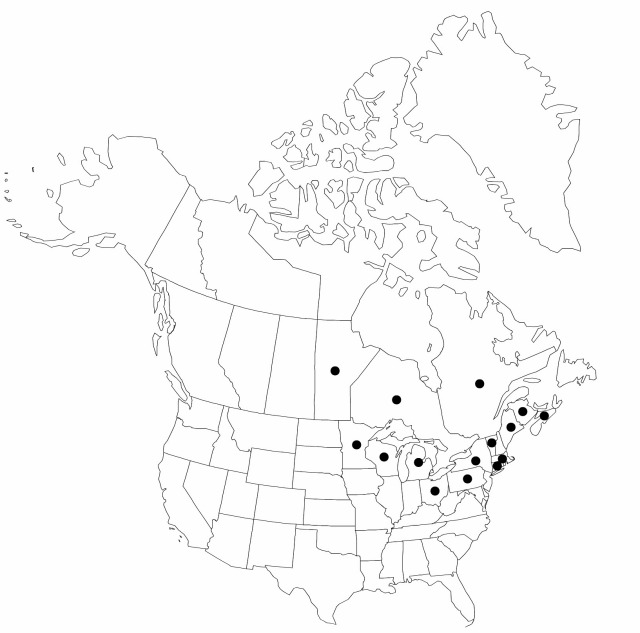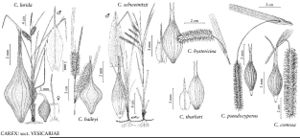Difference between revisions of "Carex pseudocyperus"
Sp. Pl. 2: 978. 1753.
FNA>Volume Importer |
imported>Volume Importer |
||
| (5 intermediate revisions by 2 users not shown) | |||
| Line 8: | Line 8: | ||
}} | }} | ||
|common_names=Carex faux-souchet | |common_names=Carex faux-souchet | ||
| + | |special_status={{Treatment/ID/Special_status | ||
| + | |code=F | ||
| + | |label=Illustrated | ||
| + | }} | ||
|basionyms= | |basionyms= | ||
|synonyms= | |synonyms= | ||
| Line 33: | Line 37: | ||
-->{{#Taxon: | -->{{#Taxon: | ||
name=Carex pseudocyperus | name=Carex pseudocyperus | ||
| − | |||
|authority=Linnaeus | |authority=Linnaeus | ||
|rank=species | |rank=species | ||
| Line 47: | Line 50: | ||
|publication title=Sp. Pl. | |publication title=Sp. Pl. | ||
|publication year=1753 | |publication year=1753 | ||
| − | |special status= | + | |special status=Illustrated |
| − | |source xml=https:// | + | |source xml=https://bitbucket.org/aafc-mbb/fna-data-curation/src/2e0870ddd59836b60bcf96646a41e87ea5a5943a/coarse_grained_fna_xml/V23/V23_951.xml |
|genus=Carex | |genus=Carex | ||
|section=Carex sect. Vesicariae | |section=Carex sect. Vesicariae | ||
Latest revision as of 20:44, 5 November 2020
Plants densely to loosely cespitose; rhizomes short, no more than 10 cm. Culms trigonous in cross section, 25–100 cm, scabrous distally. Leaves: basal sheaths pale brown (rarely faintly red tinged); ligules usually much longer than wide; blades mid to dark green, flat to W-shaped, 4–13 mm wide, glabrous. Inflorescences 4–15 cm; proximal bract 12–55 cm, greatly exceeding inflorescence; proximal 2–5 spikes pistillate, erect or the proximal pendent, cylindric, 9–12 mm thick; terminal 1 spike staminate or, rarely, gynaecandrous, androgynous, or mixed. Pistillate scales lanceolate-acuminate, 2.5–8.6 × 0.3–0.6 mm, the distal shorter and the proximal longer than perigynia, margins ciliate, apex scabrous-awned. Staminate scales scabrous-awned, sometimes also ciliate-margined. Perigynia spreading to reflexed at maturity, strongly 12–20-veined, veins usually separated by less than 2 times their width, confluent at or proximal to mid beak (except for 2 prominent lateral), tightly investing achene, narrowly elliptic to lanceolate, 3.4–6.1 × 1–1.7 mm, leathery, apex gradually tapered; beak poorly defined, 1.2–2.2 mm, strongly bidentate, teeth straight or slightly out-curved, 0.7–1.2(–1.4) mm. Stigmas 3. Achenes pale brown, trigonous, smooth. 2n = 66.
Phenology: Fruiting Jun–Aug.
Habitat: Swamps, wet thickets, stream, pond, and lakeshores, depressions in wet meadows, marshes, often in shallow water or on emergent stumps, floating logs, floating mats of vegetation in water
Elevation: 0–800 m
Distribution

Man., N.B., N.S., Ont., Que., Conn., Maine, Mass., Mich., Minn., N.Y., Ohio, Pa., Vt., Wis., Eurasia.
Discussion
Carex pseudocyperus is a smaller and more slender plant than C. comosa, but otherwise very similar. The two species often grow together where their ranges overlap and rarely produce sterile hybrids. Hybrids with C. hystericina are more frequent, and resemble C. pseudo- cyperus except for their sterility, the slightly more inflated and less reflexed perigynia, and the substantial red tinging on the basal sheaths.
Selected References
None.
